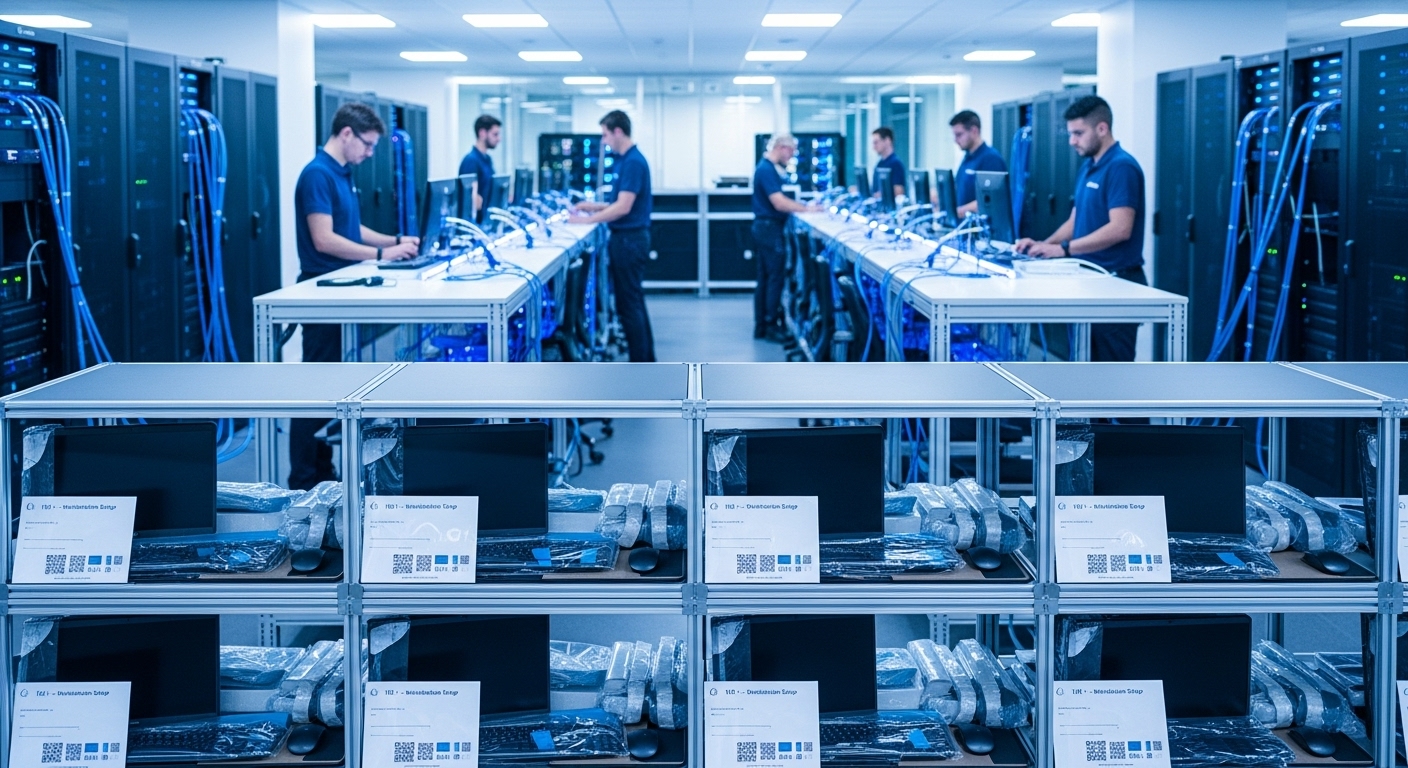Relocating an office is often seen as a landmark of growth and opportunity—a new space, a fresh start. Yet, beneath the excitement lies a complex logistical challenge that can make or break business continuity: the IT relocation. Moving desks and chairs is one thing; transplanting the digital heart of an organization is another entirely. A poorly executed IT move can trigger catastrophic downtime, data loss, and crippling productivity slumps that echo for months. The cost of just one hour of downtime for a large enterprise can run into the hundreds of thousands of dollars, a risk no growing company can afford. This guide moves beyond simple setup checklists to provide a comprehensive strategic framework for a seamless shift. We will dissect the process of architecting a flawless IT relocation and decommissioning strategy, ensuring your technology infrastructure doesn’t just survive the move but arrives stronger, more resilient, and perfectly aligned with your future ambitions.
Chapter 1: The Pre-Migration Audit: Mapping Your Digital Estate
Before a single server is unplugged, a successful IT relocation begins with a meticulous audit. You cannot move what you do not understand. This foundational phase is about creating a comprehensive inventory—a digital Domesday Book—of your entire technology ecosystem. Start with the physical hardware: catalog every server, switch, router, firewall, workstation, and peripheral. Document their specifications, age, warranty status, and physical location. This data is crucial for deciding what is worth moving, what should be upgraded, and what is destined for retirement. But the audit goes far beyond tangible assets. You must map your software landscape, including operating systems, business applications, and virtual machine configurations. Pay close attention to licensing agreements; many are tied to specific hardware or locations and will need to be addressed before the move. Equally important is understanding your data. Where does it live? How is it backed up? What are the critical dependencies between different applications and databases? Creating a detailed network diagram and data flow map is non-negotiable. This visualization will become your primary navigational tool, highlighting critical systems that require special handling and revealing interdependencies that could otherwise cause unforeseen complications during the migration sequence. This exhaustive audit is your insurance policy against the unknown, transforming a potentially chaotic process into a predictable, manageable project.
Chapter 2: The Decommissioning Blueprint: Retiring Legacy Systems Responsibly
An office move is the perfect opportunity to shed technological baggage. Decommissioning legacy hardware and software isn’t just about clearing space; it’s a critical step for security, cost-efficiency, and environmental responsibility. Once your audit has identified the equipment slated for retirement, the first priority is data security. Simply deleting files is insufficient. All storage media containing sensitive information must undergo secure data destruction. This can involve cryptographic erasure, multi-pass data wiping techniques compliant with standards like DoD 5220.22-M, or physical destruction through degaussing or shredding. Documenting this process with certificates of destruction is vital for compliance and auditing purposes. The next consideration is environmental disposal. E-waste is a significant environmental hazard, and regulations governing its disposal are increasingly strict. Partner with a certified e-waste recycling vendor who can guarantee responsible handling of materials and provide a clear chain of custody. This not only ensures compliance but also aligns with corporate social responsibility goals. Finally, address the logistical aspect of removing the old gear. This often involves coordinating with facilities teams to safely disconnect and remove heavy server racks and equipment without disrupting any systems that are still operational. A clear decommissioning plan prevents old, vulnerable hardware from being forgotten in a corner, creating a security risk, and ensures your new office starts with a clean, efficient, and secure technological slate.
Chapter 3: Architecting for Arrival: Designing the New IT Environment
While you’re planning the departure from the old space, you must simultaneously architect the technological foundation of the new one. This is a rare chance to design an IT environment from the ground up, aligning it perfectly with future business needs rather than adapting to existing constraints. The process begins with close collaboration with architects and facilities managers. Crucial infrastructure considerations like power capacity, cooling (HVAC), and physical server room security (including access control and fire suppression) must be addressed early in the design phase. Under-provisioning these resources can lead to major limitations and costly retrofits down the line. Next, focus on the network cabling infrastructure. Plan for both current and future bandwidth needs, strategically placing network ports and wireless access points to ensure comprehensive coverage and eliminate dead zones. A well-designed structured cabling system is the backbone of a high-performance office. Use the relocation as a catalyst for technological upgrades. Is it time to move from on-premise servers to a hybrid cloud model? Can you upgrade your network core to 10GbE for faster performance? Evaluating and integrating new technologies during this phase is far more efficient than trying to implement them after the fact. The final design should be a detailed blueprint, encompassing everything from rack elevations in the server room to the placement of Wi-Fi access points on the office floor plan. This meticulous planning ensures that when the moving trucks arrive, the new environment is not just ready, but optimized for performance, scalability, and security from day one.
Chapter 4: The Migration Masterplan: Sequencing for Minimal Downtime
The migration masterplan is the strategic core of your relocation project, a detailed script that sequences every action to minimize operational disruption. The ultimate goal is to achieve a ‘zero-downtime’ or ‘near-zero-downtime’ move, which requires painstaking coordination. Your plan should be broken down into distinct phases, often scheduled over a weekend or holiday period to reduce impact on business hours. First, decide on your migration strategy. A ‘lift and shift’ approach, where you physically move existing servers, is often quickest but carries higher risk if something goes wrong. A phased migration, where services are gradually failed over to new hardware or a cloud environment, is safer but more complex. For critical services, you might implement a parallel environment at the new site, running it concurrently with the old one for a period before making the final cutover. The masterplan must be incredibly granular. It should detail who is responsible for each task, the exact time each server will be shut down, the transportation logistics, and the precise order in which systems will be brought back online at the new location. Build in go/no-go checkpoints before each critical phase. These are moments to pause and verify that all prerequisites have been met before proceeding. As the industry analyst firm Gartner notes:
‘IT downtime costs can be substantial, with an average cost of $5,600 per minute, which extrapolates to well over $300,000 per hour.’
This statistic underscores the financial imperative of a flawless plan. Your migration masterplan is the ultimate tool for mitigating this risk, transforming a high-stakes operation into a controlled and predictable sequence of events.
Chapter 5: Data in Transit: Ensuring Security and Integrity During the Move
Your data is at its most vulnerable when it is physically in transit between locations. A robust security plan for this phase is non-negotiable. The risk of data loss, theft, or damage is real, and the consequences can be devastating from both a financial and reputational standpoint. The first line of defense is encryption. All data on servers, hard drives, and backup tapes must be encrypted at rest before they are moved. This ensures that even if a device is lost or stolen, the information it contains remains inaccessible. The second pillar of transit security is establishing a clear and unbroken chain of custody. This means knowing exactly who has control of your assets at every moment. Use a professional moving company that specializes in handling sensitive IT equipment. Assets should be inventoried and sealed in tamper-evident containers before they leave the old site, and this inventory should be verified immediately upon arrival at the new location. For extremely sensitive hardware, you might require a dedicated, GPS-tracked vehicle and security escorts. Don’t forget about backups. Before any migration begins, perform a full, verified backup of all systems. A second backup should be stored at a secure, off-site third location. This provides a crucial fallback position in a worst-case scenario. By treating your data’s physical journey with the same level of security you apply to your digital network, you protect your organization’s most valuable asset during its most perilous moment.
Chapter 6: The Go-Live Gambit: Execution and Post-Migration Validation
This is the moment of truth. The Go-Live phase is where meticulous planning meets real-world execution. Your migration masterplan now becomes the team’s operational playbook. Clear roles and responsibilities are paramount: the IT team handles the technical aspects, facilities managers oversee the physical environment, and specialized movers manage the transportation. Communication is key; establish a command center and use a dedicated communication channel (like a group chat or conference bridge) to keep all stakeholders updated in real time. As equipment arrives at the new site, it should be installed according to the pre-designed rack elevations and network diagrams. Once everything is physically in place and powered on, the critical process of post-migration validation begins. This is not a cursory check. It’s a systematic and exhaustive testing procedure. Begin at the physical layer, verifying power and network connectivity for every device. Move up the stack to test network services like DHCP and DNS. Then, test access to every critical application, database, and file share. A pre-defined testing plan with a checklist of pass/fail criteria for each system is essential. Involve a small group of end-users or department heads to perform user acceptance testing (UAT), ensuring that workflows function as expected from their perspective. Only after every item on the validation checklist is marked as ‘pass’ can the migration be considered a success. This rigorous testing is the final quality gate that prevents minor post-move glitches from escalating into major business disruptions.
Chapter 7: Post-Move Optimization: Fine-Tuning for Future Growth
Crossing the finish line of a successful IT migration is a cause for celebration, but the work isn’t over. The post-move period is a critical window for optimization, documentation, and strategic refinement. Your new IT environment, while thoroughly tested, will need fine-tuning as it handles real-world workloads. Implement enhanced performance monitoring tools to watch for network bottlenecks, server resource contention, or unusual application behavior. This proactive approach allows you to address issues before they impact users. The single most important post-move task is updating your documentation. Every diagram, inventory list, and configuration guide must be revised to reflect the new state of your infrastructure. This ‘as-built’ documentation is invaluable for future troubleshooting, upgrades, and team onboarding. Conduct a post-mortem review session with all stakeholders involved in the move. What went well? What challenges were encountered? What lessons were learned? Capturing this knowledge is crucial for refining your processes for any future projects. Finally, take this opportunity to train your staff on any new systems or procedures implemented during the move. A successful relocation is not just about the technology; it’s about empowering your team to leverage it effectively. By dedicating resources to this final phase of optimization and knowledge capture, you solidify the strategic gains of the relocation, ensuring your new IT infrastructure serves as a robust and scalable platform for years of future growth.
In conclusion, a seamless IT shift is a project of immense strategic importance, far transcending a simple logistical exercise. It’s a multipart symphony that demands precision at every stage, from the initial, granular audit of your digital estate to the responsible decommissioning of legacy systems. The success of the venture hinges on forward-thinking design of the new environment, a meticulously sequenced migration masterplan that treats downtime as the enemy, and an unwavering focus on data security while in transit. The culmination of this planning is a disciplined execution and a rigorous post-move validation process that leaves no stone unturned. By approaching an IT relocation with this level of strategic depth, organizations do more than just change their address. They seize a rare opportunity to shed technical debt, enhance security, and build a resilient, high-performance technology foundation. A well-executed move is an investment that pays immediate dividends in business continuity and positions the company on a powerful trajectory for future innovation and growth in its new home.





